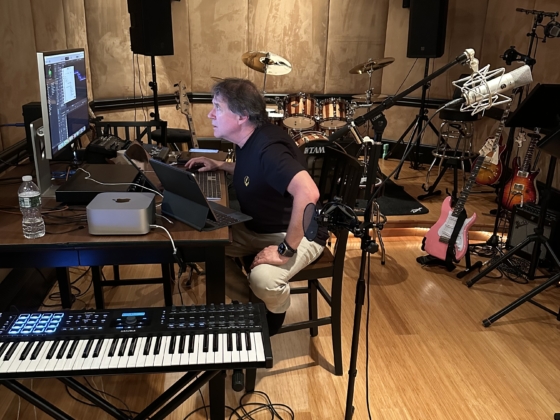Teenage Engineering’s OP-1 is the ultimate portable studio. Debuting in 2011 with high expectations, it fits tightly packed inside of a single piece aluminum body and comes with an impressive all-in-one synthesizer, drum machine, sampler and tape recorder. It takes travel sized professional audio production to a new level, but don’t let its playful appearance fool you, the OP-1 is as powerful a recording tool you could find.
CUT TO THE CHASE
[gear_specs_box]
The good: At it’s heart, the OP-1 is a 4 track recording device with a virtual tape recorder containing the recorded audio which can be taken from a few sources within the machine itself, and whether you’re sampling from its microphone or FM radio input, recording synth sounds straight from the 8 synth engines, or playfully programming your percussion in the drum machine, you’ll be viewing each and every parameter on the beautifully lit 320 x 160 pixel OLED color screen.
The bad: Fixed velocity keys means you do lose some expressiveness if you’re used to velocity sensitive keys, but it probably has everything to do with keeping the profile of the OP-1 to a minimum and the cost under $1000.
The deal breaker: Portability. Countless touring musicians will tell you they don’t leave home without the OP-1, as it provides simple but unique means to endless audio creation without the distractions of an iPad or laptop. You can quickly jot down ideas for chord progressions and drum patterns and with a built in sampler and 3.5mm in and outs you’ve got everything you need. OS updates from Teenage Engineering continue to improve the unit with new and innovative sequencers and effects and the machine can also be used as a midi controller for any DAW.
BEHIND THE SCENES
The four colored rotary encoders aren’t just for show, they directly correspond to what is shown on the OP-1’s screen as each colour changes a different parameter, allowing for easy control for beginners and experts alike. You’ll spend less time memorizing what each knob controls and more time enjoying the sounds you’re able to create with such ease, as the 4 different parameters are automatically assigned to each control synth as you move through them, effecting things like frequency, phase shift, filter cutoff, chorus, wave type, number of waves, detune and amplitude among many others, and also gives you full access to ADSR envelopes for all the sounds. The 8 synth engines and counting allow you the flexibility to create virtually any sound desired.
At the recent NAMM show, Teenage Engineering revealed an exciting new OS update featuring (among other things) a synth modelled on the OP-1’s existing drumbox drum machine, as well as a new sequencer called Sketch which acts like an etch-a-sketch (shake to erase and all!) and allows you to draw in sequences using two knobs for some unique results. It’s updates like these that really give you the most of the $800+ price tag because you know you aren’t buying an instrument or controller that will be replaced in two years with a new model (this same design has been in production since 2011 without alteration!), but rather improved upon each year with new effects, sequencers, and synths.

At this point, there’s the Cluster, Digital, String, Pulse, FM, Phase, and Dr Wave synth engines as well as the synth sampler and drum sampler, and the drumbox drum machine, each with unique parameter controls assigning themselves to the knobs. There’s a true analog sound to some of the synths, while others enhance it digitally to no end. The dual pulse oscillator synth and the four operator FM synthesis engine produce some of the most organic sounds and likely will stand to be used in final productions. The Dr Wave has proven to be the most versatile for anything atmospheric to melodic and droney, while another engine aims to reproduce (and successfully) real life string sounds. As you scroll through the presets that TE has provided it really impresses to hear the variety and complexity of some of the sounds that are produced by such a small machine which can be taken literally anywhere, charged via usb and used for 16 hours straight (or 2 years stand-by time).
One of the most practical features of the OP-1 is the sampler. There’s a built in microphone or a 3.5mm mini jack line in which gives you instant access to any sound from external sources, whether you want to rip drum sounds from your computer, sample a synth patch from your favourite old analogue machine, or record audio straight from the FM radio, it’s incredibly easy to use and you have the option of sampling either 6 seconds into the synth sampler or 12 seconds into the drum sampler. In the synth sampler your recorded clip will be chromatically arranged across the 24 keys, while in the drum sampler your 12 second clip is cut up into 24 parts, each assigned to a separate key, and the four encoders act as start and end points and loop markers to edit each part easily and making for a quick and fun approach to remixing.

There’s 4 sequencers that are currently available on the OP-1 and with more on the way the future is bright for this young startup company. Teenage Engineering has already created the endless sequencer which allows you to sequence melodies however long you choose with incredible ease. There’s also the pattern sequencer which acts much like some old drum sequencers and allows you to meticulously program in a pattern over 16 bars and gives you the ability to edit after. The finger sequencer shows on screen either a set of monkeys playing drums or a couple of hipsters playing synths, and actually gives you the most versatility of any of the sequencers, allowing multiple sequences to be stored across the 24 keys so you can easily add variation to a pattern. The final sequencer as of now is the Tombola, essentially a rotating hexagon that you trigger synth or drum sounds to fall down and hit the sides of the spinning hexagon. Rather hard to explain but absolutely beautiful to watch on the OP-1 screen and makes for some interesting results. Check out the video with a screen capture and all original sounds coming from the unit itself to see some sequencers and effects at work.
[youtube]https://www.youtube.com/watch?v=su0QlLok5tw[/youtube]
The 7 on board effects of the OP-1 can be applied to both the master and also to each individual synth or drum that is loaded, so you have two layers of effects to work with at all times. While they aren’t overly complicated they do add their bit of flare to the result and like every feature on it, the effects are meant to be fun, just look no further than the funky CWO filter that came with a recent OS update and pictures a cow on screen! From there we go into two very unique delays and then comes another filter, this time featuring both hi pass and low pass with resonance control. Then there’s the phone effect which essentially takes your input and spits out 8 bit sounds resembling all too much an old dial tone. Another filter called Punch seems to be one of the most useful tools on the OP-1 for getting the most bass out of a sound, as it’s low pass filter really can boost your serious sub. Finally we get to the spring reverb with tone and damping control, and while there’s only 7 effects they are all controllable by any one of the 7 LFOs available, including the option to input with the microphone or FM radio, and movement.
We couldn’t complete this review without talking about the 3 axis g-force motion sensor that is housed within the single piece aluminum body of the OP-1. It can be assigned to any pitch, synth, envelope, or effect parameter and with the sturdy and compact build you can be sure you won’t damage anything by flinging the unit around (actually a very unique and productive way of applying a parameter change). While there's really an endless amount of fun you can have with this little beast, it might just be best to showcase the sounds that you're actually able to create. There's a group on Soundcloud with over 1000 members dedicated to the OP-1 and with the OhPeeWon.com forum you've got more than enough support, while incredible talents like Cuckoo keep the community inspired and demonstrate the full potential of the OP-1.
[youtube]https://www.youtube.com/watch?v=XQL29CMLLdc[/youtube]









